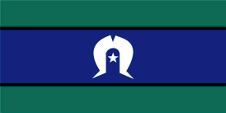Torres-Straße-Inseln |
|
|
|
| Übersicht – Contents: | |
Diese Seite ist Teil des Projektes
Torres-Straße-Inseln |
|
|
|
| Übersicht – Contents: | |
Flagge – Flag: |
|
 |
Flagge der Torres-Strait-Insulaner – flag of the Torres Strait Islanders, Seitenverhältnis – ratio = 1:2, Quelle/Source, nach/by: Flags of the World   |
| Die heutige Flagge der Torres-Strait-Insulaner wurde am 29.05.1992 anlässlich der Besetzung der Insel Murray durch Eingeborene erstmals in der Öffentlichkeit gezeigt und wurd am 14.07.1995 mit dem Flaggegesetz 1953 amtlich eingeführt und erhielt damit, zusammen mit der australischen Aborigine-Flagge, einen offiziellen Status. Die Flagge wurde von Bernard Namok geschaffen und zeigt fünf Streifen in Grün, Schwarz, Blau, Schwarz und Grün, wobei die schwarzen Streifen schmale Trennstreifen sind. In der Mitte des blauen Streifens erscheint ein weißes Emblem mit einem fünfzackigen weißen Stern. Die Farbe Grün steht für die Inseln, Blau für den Ozean, Weiß für Frieden und Schwarz für die Bevölkerung. Das weiße Emblem ist die Kopfbedeckung (Dhari) eines eingeborenen Tänzers und steht für das Volk. Der Stern gilt als Symbol für die Navigation und seine fünf Zacken repräsentieren für die fünf Regionen der Inselgruppe. Die Farben sind festgelegt, letztmalig als Blau = Pantone 280 c und Grün = Pantone 342 c. |
The today's flag of the
Torres Strait Islanders was first shown in public on 29th of May in 1992 on
the occasion of the occupation of Murray Island by natives and was
officially introduced on 14th of July in 1995 with the Flag Act 1953, and
got – along with the Australian Aboriginal flag – an official status. The flag was created by Bernard Namok and features five stripes of green, black, blue, black and green, with the black stripes being narrow dividing stripes. A white emblem with a five-pointed white star appears in the center of the blue stripe. The colour green represents the islands, blue stands for the ocean, white stands for peace and black for the population. The white emblem is the headgear (dhari) of a native dancer and represents the people. The star is a symbol of navigation and its five points stand for the five regions of the archipelago. The colours are fixed, last time as blue = Pantone 280 c and green = Pantone 342 c. |
|
Quelle/Source: Flags of the World, Wikipedia (EN) |
|
Landkarte – Map: |
|
Landkarte des Landes – Map of the Country:
Größere Karte anzeigen – View larger map Keine Karte? No map? → |
|
|
| Zahlen und Fakten – Numbers and Facts: | |
|
|
|
|
|
|
|
|
|
|
|
|
|
|
|
|
|
1606
· Entdeckung der Inseln durch den niederländischen Seefahrer Willem Janszoon 1606 · der spanische Seefahrer Luiz Vaéz de Torres besucht die Inseln und entdeckt die Durchfahrt zwischen Neuguinea und Australien (Torres-Straße), diese Entdeckung wird von Spanien über 150 Jahre geheim gehalten 1770 · der britische Seefahrer James Cook besucht die Inseln und nimmt sie für Großbritannien in Besitz 26.06.1879 · die Torres-Straße-Inseln werden ein Teil der britischen Kolonie Queensland 1901 · Queensland wird Bundesstaat von Australien 29.05.1992 · Eingeborene nehmen die Insel Murray in Besitz, als ersten Schritt zur Autonomie der ganzen Inselgruppe, die Inbesitznahme wird durch die Australische Regierung anerkannt 01.07.1994 · die Torres-Straße-Inseln erhalten Autonomie von Queensland |
|
1606
· discovery of the islands by the Dutch seafarer Willem Janszoon 1606 · the Spanish seafarer Luiz Vaéz de Torres visits the islands and discovers the passage between New Guinea and Australia (Torres Strait), that discovery becomes a by Spain hold secret for over 150 years 1770 · the British seafarer James Cook visits the islands and appropriates them for United Kingdom 26th of June in 1879 · the Torres Strait Islands become a part of the British colony of Queensland 1901 · Queensland becomes a feeral state of Australia 29th of May in 1992 · natives appropriate Murray Island as a first step in the directon of autonomy for the whole archipelago, the appropriation becomes recognized by the Australian government 1st of July in 1994 · the Torres Strait Islands get autonomy from Queensland |
| Quelle/Source: Discovery '97, Wikipedia (DE), Volker Preuß |
| Die Torres-Straße-Inseln sind nach der Meerenge benannt (Torres-Straße), in der sie liegen, zwischen dem Australischen Kontinent und der Insel Neuguinea. Benannt wurde sie nach dem spanischen Seefahrer Luiz Vaéz de Torres, der im Jahre 1606 als erster durch diese Meerenge segelte. | The
Torres Strait Islands are named after the water-strait between the
Australian continent and New Guinea Island in which they placed (Torres
Strait). It is named after the Spanish seafarer Luiz Vaéz de Torres, which sailed as first though this strait in the year 1606. |
| Quelle/Source: Volker Preuß | |